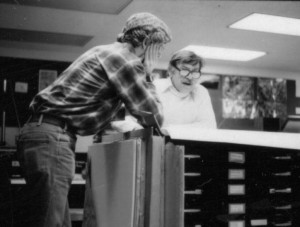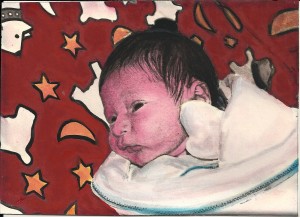The other day, Jose Luis Garcia-Lopez posted on Facebook some photos he took at DC Comics in the 1970s, when the company resided in 75 Rockefeller Center. Among them was this one, snapped in the production department. On the left is letterer supreme Todd Klein; on the right is production maven and king of covers and colorists, Bob LeRose (June 3, 1921 – August 30, 2006).
More, er…seasoned fans will no doubt recognize the name from the credits on a ton and a half of beautifully colored stories from the 1970s through the early-2000s, everything from Superman and Batman to Jonah Hex and the Haunted Tank, and every other genre in between.
Bob was and remains one of my favorite people ever from my own long association with DC. I started at the company as a writer in 1975 and served a brief turn on staff in 1977 – 1978 doing public relations work (a job cut short by the infamous DC Implosion), right around the time Bob came on staff. During that time, I wrote a series of half-page filler pieces called “DC Profiles,” short bios of various staff and freelancers that ran in the books. This is the one I wrote about Bob sometime in 1978:
DC Profile: Bob LeRose
Over the last two years the name Bob LeRose has been appearing with ever increasing frequency over the colorists credit in many DC Comics. But just because Bob is new to our readers doesn’t mean he’s new to the field…in fact, he brings to his job 30 years of experience.
Born in New York in 1921, Bob’s only interest in the newspaper comic strips of the day was as a source of ideas from which he could practice his own drawing skills.
As with most young men of the time, World War II pre-empted several years of Bob’s life, but after his release from the service he enrolled in the New York Phoenix School of Design. It was there that he was able to study illustration, water colors and, for a change of pace, commercial layout.
After finishing school, it was that “change of pace” course which landed him a position as Assistant Production Manager at Johnstone and Cushing, an advertising agency specializing in comic ads. Bob’s immediate superior at the agency was Al Stenzel, the man in charge of producing ads in the form of comics.
Alongside such now legendary comics folk as Lou Fine, Leonard Starr, and Creig Flessel, Bob worked at the agency until 1950. It was also around the time he decided to give up illustration and focus his energies on the production end of comics. “I figured it was better to be a first-rate layout man than a second-rate artist,” Bob said.
It was in 1960 that Al Stenzel left Johnstone and Cushing to set up his own studio, taking Bob along as his right-hand man. Working alongside the man he calls “the Toscanini of comics” taught Bob virtually everything he knows about the production and business of comics
The following year, Stenzel’s studio began producing the comics section for Boys’ Life, the official magazine of the Boy Scouts. And, as the studio’s production manager, Bob gave a young artist named Neal Adams his first commercial comics assignment.
In 1976, Bob parted company with Stenzel and came to work in DC’s production department where he soon earned the title of Assistant Production Manager, in charge of covers, special material, and advertising. And, as if the responsibilities that go with that job weren’t enough, Bob fills what little free time he may have coloring many of DC’s top titles.
Bob’s philosophy has always been, “Find out what you do best and do it!” We think that’s pretty good advice for anybody, from newcomers to seasoned professionals … especially since we’ve seen how well it worked for Bob.
+ + +
In 1990, I returned to the DC staff, this time as an editor (there were a couple of short stints in PR and editorial in between; until the recent, uber-corporatized regime, I was pretty much happily joined at the hip with DC … but that’s a whole other story). For the next half dozen years or so, I had the pleasure and privilege of dealing with Bob LeRose on pretty much a daily basis. Bob was still in production, still in charge of covers. When I handed in an art, rough layout, and color guide, it was given to him to turn into an actual, workable cover. Since the colorist received only the base art, it was up to Bob to decide the color scheme of the logo, blurbs, and any other elements I added.
I quickly learned that my covers were in excellent hands. Bob’s sense of color and design were, as far as I was concerned, all but flawless. If he said the logo should be a blue and yellow of these specific values to work best with the color scheme laid down by the colorist, he was seldom wrong. And if by some chance he was, he would be the first to see it and make the change. Likewise, if he came to me with the cover laid out as I had called for and told me it didn’t work, I didn’t need for him to explain why. I trusted his instincts 100%. I can’t tell you how many times I told him, “Bob, if you think that’s the way it should be, do it. You are the master.” He was, after all the king of covers.
Bob admired the talented colorists whose work he shepherded through DC’s production department. I was fortunate enough to work with some amazing talents on many of my books, but the best example of an unbeatable team would have to be the run of covers created for Wonder Woman by Brian Bolland and colored by the breathtaking Tatjana Wood. To this day, I don’t think there have been many better colorists in comics than Tatjana (one-time wife of Wally Wood), whose work dated back to EC Comics and who was, in addition, an artist and textile designer. Bob, himself no slouch with a brush and a set of Dr. Martin dyes (the colored inks once used when comics were still colored by hand and not on a computer), admired Tatjana tremendously, but sometimes felt a change in her color guide was necessary in order to create the best effect. Bob would always make the change reluctantly and with just a smidge of guilt. Tatjana never once, to my recollection, objected to his changes. She trusted Bob.
I could go on with stories about Bob, but three anecdotes kind of tell it all:
One: I was in the production department waiting to talk to Bob about one of my covers. Ahead of me was a fairly new assistant editor, a guy in his early twenties new to the field and quite full of himself for being part of the team on a then-high profile character line of titles. Fancying himself an artist, the young assistant editor was explaining to Bob how and why this particular cover should be done the way he was asking, as if he were the seasoned professional and Bob was the wet-behind-the-ears newbie. Bob, with a straight face and in absolute seriousness, listened to this kid’s lecture on color theory, nodding in understanding. When the lesson was over and the kid had gone back to his office, I said to Bob, “Jeez, why do you let that arrogant little bastard talk to you that way. You’ve forgotten more about coloring than he’ll ever know.” Bob just shrugged, smiled his gentle smile, and, without a trace of malice, said, “He’s young. He’ll learn.”
Two: When my son was born in April, 1996, I lined my desk, as all proud papas will do, with photos. One day, I returned to my office to find a tissue paper wrapped gift waiting for me. It was from Bob; at some point, he had borrowed a picture from my desk, made a black and white photocopy of it on watercolor paper, and hand-colored and framed it as a gift. That picture has been on my desk or prominently displayed in my living room ever since and I never fail to think of Bob and smile whenever I look at it.
Three: Sometime in early 2006, my phone rang at home. When I answered, a familiar albeit weakened voice said, “Hello, is this Paul? This is Bob LeRose. Do you remember me?” Bob had semi-retired from DC in 1996 but still came into the office once a week until the emphysema from which he suffered prevented him from doing even that much. Bob’s wife, the mother of his three children, had died in 1992 and, in 2002, he married Veronica, the healthcare worker who had begun caring for him when the lung disease made it difficult for him to be on his own. “Of course, I remember you, Bob,” I said. “You’re a pretty unforgettable guy.”
We talked for ten or fifteen minutes; it was obvious he was suffering from some mild dementia, whether due to the emphysema or Alzheimer I don’t know. But he recalled much of his time at DC well enough and we talked about the good old days and some of the people we knew. By then, he was laboring for breath, so it was time to say good-bye. I told him how good it was to hear his voice again and hoped he was feeling better soon. He thanked me and, just before we hung up, Bob asked again, “You do remember, don’t you?” I assured him I did and he sounded relieved, as if in his present condition he needed that validation of his own existence. “That’s good,” Bob said, “because sometimes I’m not so sure I remember myself.”
Here’s to memories of Bob LeRose. Color me lucky to have them.
Tags: Bob LeRose, colorist, DC Comics, King of Color


Nice story and so sorry I never knew him, especially as I did visit the office many a time while he was still there. Would have had something to talk about too, as he’s almost the only person in the biz that I’ve heard of who came from my school the New York Phoenix Schools of Design (which became Pratt-Phoenix while I was there only to be obliterated by them not long after almost a century of being there in Manhattan, He probably knew my anatomy teacher who told me I already knew too much and had me practicing inking with a brush instead. That teacher, Cliff Young, did the art for Vigilante and Green Arrow back in the 40’s, and odds are Bob would have known him…
Gad, I miss him…
He was a great man. I was lucky enough to be his niece. He was so talented.
You were lucky indeed, Elsie. Bob was a sweet (and talented) man.
Such a sweet story and sweet man Bob aka grandpa was. I’ve got his artwork hung with pride on my walls…. Even tattooed some of his artwork on(not sure he’d approve of the exact coloring the tattoo artist did lol) my body.
Bob LeRose was my father. There is not a day that goes by when I don’t think of him. He taught me all about the colors. How they work, what they do. He was a great man. I still miss him every day. He was such a great talent and it was only into his 60’s – 70’s that I think people really realized how very talented he was. I have his pictures hanging on my walls. Thank you for all the kind commentary to his life.
It was my pleasure, Roberta, and my even greater pleasure to know your dad.